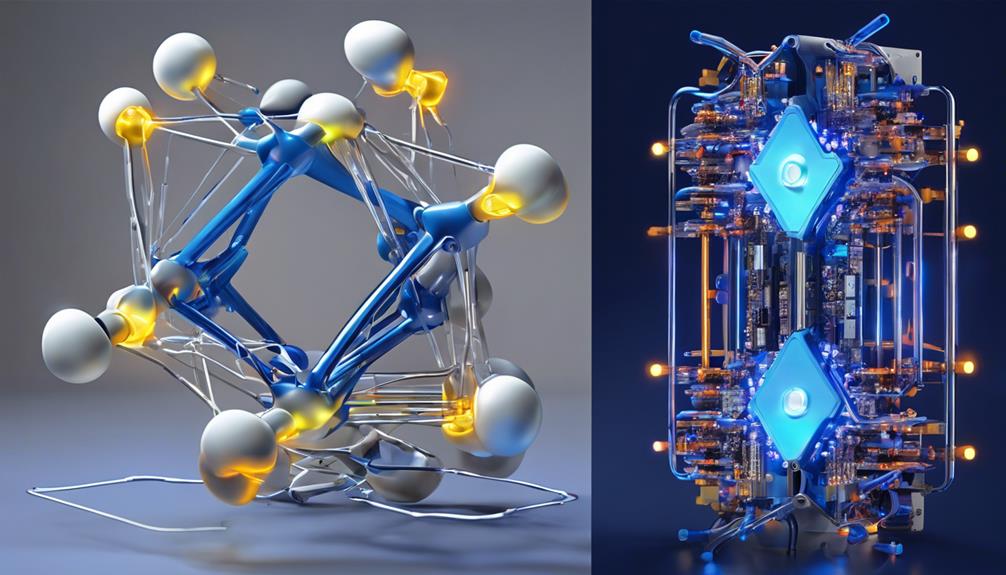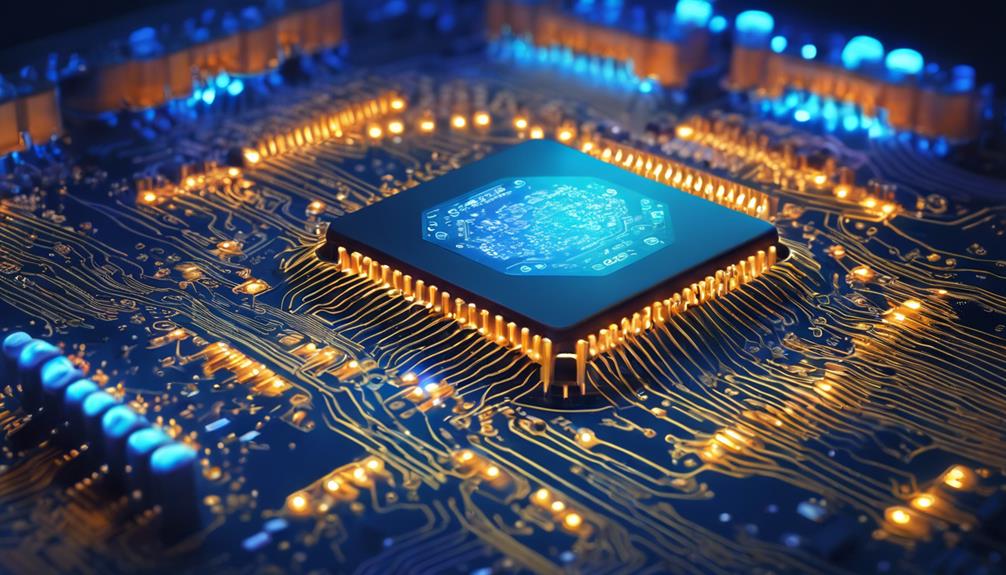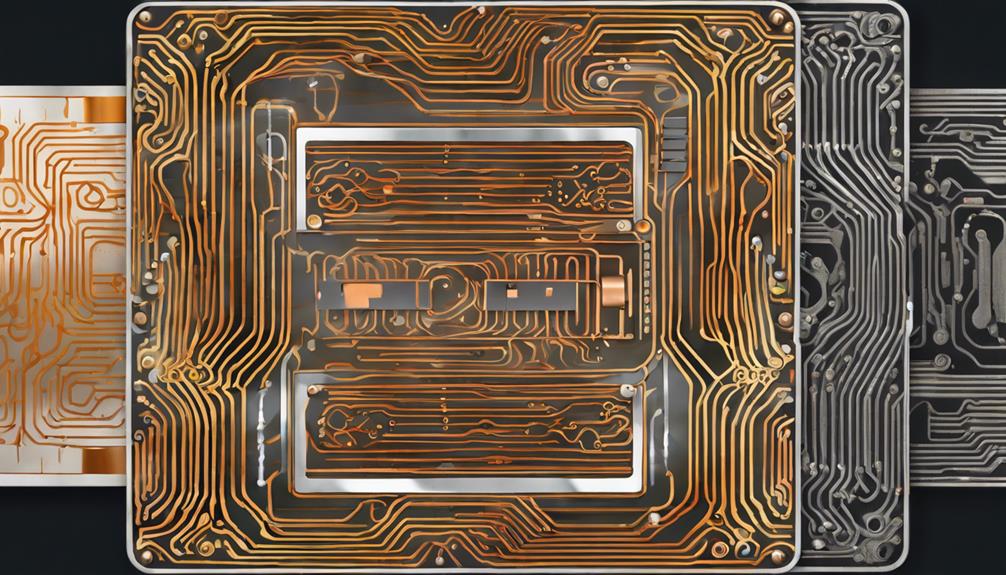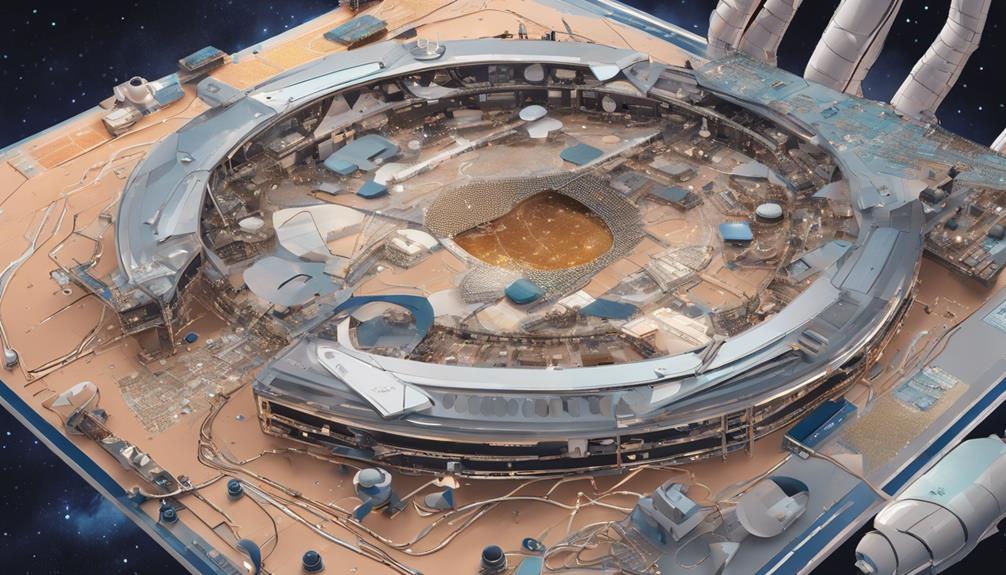When selecting laminate materials for LED PCBs, designers and engineers require high-reliability options that can withstand thermal stresses, maintain signal integrity, and guarantee consistent performance over a wide range of frequencies. Seven top laminate materials for LED PCBs include RF-35TC, TLX-8, TLC-32, FastRise FR-7, TSM-DS3, TLY-5, and RF-30A. Each offers unique benefits, such as high thermal conductivity, low dielectric loss, and excellent dimensional stability. By understanding the features and applications of these laminate materials, designers can make informed decisions to optimize their LED PCB designs. Further exploration reveals the specific advantages and limitations of each option.
Key Takeaways
- For high-reliability LED PCBs, consider RF-30A laminate material, offering excellent thermal conductivity and low dielectric loss.
- TLC-32 is a cost-effective option for stable high-frequency performance, with a dielectric constant of 0.003 and thermal conductivity of 0.24 W/mK.
- TLY-5 laminate offers high thermal conductivity, low moisture absorption, and excellent signal integrity, making it suitable for high-frequency applications.
- For high-speed laminate options, FastRise FR-7 provides a high dielectric constant of 7.45 and thermal stability up to 200°C.
- RF-35TC laminate material is suitable for RF antennas, microwave relay systems, and satellite communication systems, with a dielectric constant of 0.002 and thermal conductivity of 0.92 W/mK.
RF-35TC: High-Frequency Laminate Solution
RF-35TC, a high-frequency laminate material, offers a unique combination of electrical and thermal properties that make it an ideal solution for high-frequency applications. With a dielectric constant of 0.002, RF-35TC guarantees low signal loss and minimal signal distortion, making it an excellent choice for microwave applications. Its thermal conductivity of 0.92 W/mK enables effective heat dissipation, further enhancing its reliability in high-frequency systems.
Compliant with IPC Slash Sheet 4103A/240, RF-35TC meets industry standards for performance and reliability. Its excellent electrical properties make it suitable for a range of applications, including RF antennas, microwave relay systems, and satellite communication systems.
Additionally, RF-35TC is designed for streamlined fabrication processes, making it an attractive option for high-frequency LED PCB designs. With its low loss characteristics and high thermal conductivity, RF-35TC is an ideal high-frequency laminate material for demanding applications where signal integrity and thermal management are essential.
TLX-8: High-Temperature Resistant Material

One notable high-temperature resistant material, TLX-8, boasts an impressive dielectric constant of 0.0018, making it an attractive option for high-frequency circuits and demanding LED applications.
This PCB material offers exceptional thermal conductivity of 0.19 W/mK, guaranteeing efficient heat dissipation in high-power LED systems. TLX-8's low loss tangent and stable electrical performance make it an ideal choice for high-frequency circuits, where signal integrity and minimal signal loss are critical.
As part of the Taconic PCB laminate series, TLX-8 provides reliable performance in demanding LED applications. Its IPC Slash Sheet, 4103A/200, ensures compliance with industry standards for quality and reliability.
With TLX-8, designers can create high-performance LED PCBs that meet the most stringent requirements. This high-temperature resistant material is well-suited for applications where thermal management is critical, making it an excellent choice for LED designers seeking a reliable and high-performing PCB material.
TLC-32: Low-Loss Dielectric Material

What distinguishes TLC-32 from other laminate materials is its exceptionally low dielectric constant of 0.003, making it an ideal choice for radiofrequency applications where signal integrity is paramount. This low-loss dielectric material offers a unique combination of properties that make it suitable for high-frequency PCB designs.
| Property | Value |
|---|---|
| Dielectric Constant | 0.003 |
| Thickness | 3.2 +/- 0.05 mm |
| Thermal Conductivity | 0.24 W/mK |
| IPC Compliance | IPC Slash Sheet 4103A/240 |
| Cost-Effectiveness | High |
TLC-32's low dielectric constant minimizes signal loss and distortion, making it an excellent choice for RF applications. Its thermal conductivity of 0.24 W/mK promotes efficient heat dissipation, reducing the risk of thermal-related failures. Compliant with IPC Slash Sheet 4103A/240, TLC-32 is a reliable choice for PCB fabrication. Additionally, its cost-effectiveness makes it an attractive option for applications requiring stable high-frequency performance.
FastRise FR-7: High-Speed Laminate Option

FastRise FR-7, a high-speed laminate material, is specifically designed to support high-frequency signal transmission in LED PCBs, boasting a dielectric constant of 7.45. This high DK (Dielectric Constant) laminate is ideal for printed circuit boards that require high-speed signal transmission.
Some key features of FastRise FR-7 include:
- High dielectric constant: 7.45, making it suitable for high-frequency signal transmission in LED PCBs.
- Thermal stability: With a glass conversion temperature (TG) of 200°C, FastRise FR-7 ensures stability in varying temperature conditions.
- Efficient heat dissipation: The thermal conductivity of 0.43 W/mK aids in efficient heat dissipation in LED PCBs.
- Certified quality: IPC Slash Sheet 4103/570 certifies the reliability and quality standards of FastRise FR-7 laminate material.
FastRise FR-7 is a reliable choice for high-speed laminate materials in LED PCBs. Its high dielectric constant, thermal stability, and efficient heat dissipation make it an ideal material for high-frequency signal transmission applications. With its certified quality, FastRise FR-7 is a trusted choice for manufacturers of printed circuit boards.
TSM-DS3: High-Frequency PCB Material

TSM-DS3, a specially crafted high-frequency PCB material, is designed to deliver exceptional electrical performance in RF and microwave applications. This material boasts an impressive dielectric constant of 0.0029, ensuring strong electrical performance. Additionally, TSM-DS3 features an industry-best dissipation factor (DF) of 0.0011 at 10GHz, making it an ideal choice for high-frequency applications.
| Property | Value | Unit |
|---|---|---|
| Dielectric Constant | 0.0029 | – |
| Dissipation Factor (10GHz) | 0.0011 | – |
| Fabrication Support | Large Format, High Layer Count | PCBs |
TSM-DS3 enables streamlined fabrication processes, supporting large format high layer count PCBs. Its exceptional electrical performance and fabrication capabilities make it an ideal material for applications such as broadband antennas, microwave relay systems, RF filters, and satellite communication systems. By leveraging TSM-DS3, designers and manufacturers can create high-performance RF and microwave systems that meet the demands of modern communication systems.
TLY-5: High-Thermal Conductivity Laminate

Designed to excel in high-frequency applications, TLY-5 high-thermal conductivity laminate offers a unique combination of exceptional electrical stability and simplified manufacturing processes. This laminate is specifically designed for RF and microwave circuits, making it an ideal choice for various applications.
TLY-5 laminate boasts several key benefits, including:
- Low moisture absorption, ensuring reliable performance in diverse environmental conditions.
- High copper peel strength, providing added durability and reliability.
- Excellent signal integrity, guaranteeing high-speed signal transmission with minimal distortion.
- Superior thermal management, effectively dissipating heat to prevent thermal-related failures.
These characteristics make TLY-5 an excellent choice for aerial surveillance, digital signal processing, RF telemetry, and satellite navigation systems.
Additionally, its high-thermal conductivity and electrical stability make it well-suited for LED PCB applications, where signal integrity and thermal management are crucial.
RF-30A: High-Power LED PCB Material

Optimized for high-power LED PCB applications, RF-30A is a superior material choice for RF and microwave circuits, offering enhanced performance and stability in demanding environments. This high-power LED PCB material is specifically designed to meet the rigorous demands of microwave applications, ensuring reliable operation in extreme conditions.
RF-30A boasts improved PIMD (Passive Intermodulation Distortion) performance, a critical factor in maintaining signal integrity in high-frequency applications. Its exceptional stability at high frequencies makes it an ideal choice for demanding LED lighting applications.
Moreover, RF-30A provides an excellent price/performance ratio, ensuring cost-effectiveness for LED PCB designs.
Common applications of RF-30A include microwave amplification, RF communication, RF switching, and satellite systems. This material's exceptional performance and cost-effectiveness make it a popular choice for designers seeking high-power LED PCB materials.
With RF-30A, designers can develop high-reliability LED PCBs that meet the stringent requirements of modern RF and microwave applications.
Frequently Asked Questions
What Are the Key Factors to Consider When Selecting a Laminate Material?
When selecting a laminate material, several key factors must be considered. Thermal conductivity, dielectric constant, and moisture absorption are essential for guaranteeing reliable performance and preventing thermal degradation.
Additionally, the material's mechanical strength, dimensional stability, and resistance to chemicals and solvents must be evaluated.
Moreover, the laminate's cost, availability, and manufacturing process compatibility should also be taken into account to secure a successful and cost-effective PCB design.
Can Laminate Materials Be Used for Both High-Power and Low-Power LED Applications?
As the ancient Greek philosopher, Aristotle, once said, 'The whole is more than the sum of its parts.'
Similarly, when it comes to laminate materials, their versatility can be leveraged to cater to diverse LED applications.
In response to the query, yes, laminate materials can be utilized for both high-power and low-power LED applications.
The key lies in selecting the appropriate material that meets the specific thermal, electrical, and mechanical demands of the intended application, thereby ensuring peak performance and reliability.
How Do Laminate Materials Affect the Thermal Management of LED Pcbs?
Thermal management is a critical aspect of LED PCB design. Laminate materials play a substantial role in this regard. The thermal conductivity of laminate materials can greatly impact the operating temperature of LEDs. High thermal conductivity materials enable efficient heat dissipation. Conversely, low thermal conductivity materials can lead to thermal hotspots, reducing LED lifespan and performance.
Effective thermal management via laminate material selection is essential for reliable and efficient LED operation.
Are There Any Environmental Concerns Related to Laminate Material Production?
Environmental concerns surrounding laminate material production are multifaceted. The extraction of raw materials, such as copper and glass fibers, can lead to habitat destruction and water pollution.
Moreover, the manufacturing process itself can result in greenhouse gas emissions and hazardous waste generation. In addition, the disposal of laminate materials at the end of their life cycle can contribute to landfill waste and environmental harm.
It is essential to take into account these environmental implications when selecting laminate materials for LED PCBs.
Can Laminate Materials Be Recycled or Reused in LED PCB Manufacturing?
In the pursuit of sustainable manufacturing, the recyclability and reusability of laminate materials in LED PCB production are vital considerations.
For instance, a study by the University of California demonstrated a 90% reduction in waste generation by implementing a closed-loop recycling system for FR4 laminates.
While this example showcases the potential for recycling, the industry still faces challenges in scaling up such initiatives.
Currently, only a limited number of laminate materials can be effectively reclaimed and reused, underscoring the need for continued research and development in this area.


